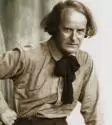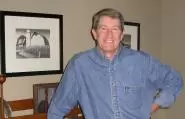Waiting For the Next Great Book

If you happened to read my column last week on William Wallace Denslow, the illustrator best known for his work with L. Frank Baum on The Wonderful Wizard of Oz (1901), but who also designed and illustrated books for Elbert Hubbard from 1896 until 1899, I have a sad epilogue.
By 1908 Denslow, who had a strong affection for seahorses, cigars, whiskey and women, which may account for his string of failed marriages, had purchased with his Oz royalties a small island off the coast of Bermuda. In typical Denslow style, he crowned himself King Denslow I.
But his royal lifestyle caught up with him, and by 1915 he was destitute, out of work and living back in New York. That March he received his first commission in months, and promptly went on a drinking spree and contracted pneumonia. Already weakened by chronic alcoholism, William W. Denslow died on March 29, 1915, at the age of 58. The passing of the once famous, best selling illustrator did not even receive a mention in the New York newspapers, and his grave remained unmarked until 1986.
A sad ending to a remarkable career — with a Roycroft connection.
Like most Arts and Crafts collectors, one of the first stories I heard was about Elbert Hubbard and the Roycrofters. More was written about Hubbard in the early years of the Arts and Crafts revival than any of his Arts and Crafts contemporaries, with the exception of Frank Lloyd Wright. In the course of my research into Denslow and his role on the fledgling Roycroft campus, I encountered names — and accounts — of early Roycrofters whom I knew scant little about: Jerome Conner, Peter Robarge, Samuel Warner and Ernest Standeven (got to love that name!).
And with it came a reminder of what the Arts and Crafts revival has not produced: a scholarly biography of Elbert Hubbard equal to David Cathers’ complete and definitive work entitled Gustav Stickley.
In 1996 Marie Via and Marjorie Searl, along with several important contributing authors, wrote Head, Heart and Hand: Elbert Hubbard and the Roycrofters. Organized around a series of essays on various departments within the Roycroft organization, the book served a valuable purpose, and remains to this day the most reliable reference on the Roycrofters.
Decades prior to that a few brief biographies of Elbert Hubbard had been attempted, but each bore a fatal flaw, most often being anxious to gloss over some of Hubbard’s human frailties, rather than to explore their origins and analyze how they affected the development of the Roycrofters.
The person who someday earns the distinction of writing the ultimate biography of Elbert Hubbard will need not only the proper credentials to open doors, file cabinets and trunks of scattered letters and documents, but the political savvy to walk the landmine-laden landscape of East Aurora, where dissention among the townspeople, the descendents of the Roycrofters, and the various owners of the remaining Roycroft buildings, workshops and records has simmered since bankruptcy was declared in 1938.
Since the roots of the original Arts and Crafts movement can be traced back to the classroom of John Ruskin, and those of the Arts and Crafts revival to the classroom of Professor Robert Judson Clark, it would seem that our hope for an unbiased, thorough account and analysis of the life and impact of Elbert Hubbard would lie within one of the universities, ideally within easy access to East Aurora.
I don’t know who is going to do it, but I hope that someone does, and does it before time erodes even more records.

Until next Monday,
Have a great week!
Bruce
PS – Don’t forget to save the date: February 22-24, when we meet again at the famed Grove Park Inn for late-night laughter, talks, demonstrations, antiques and more!
